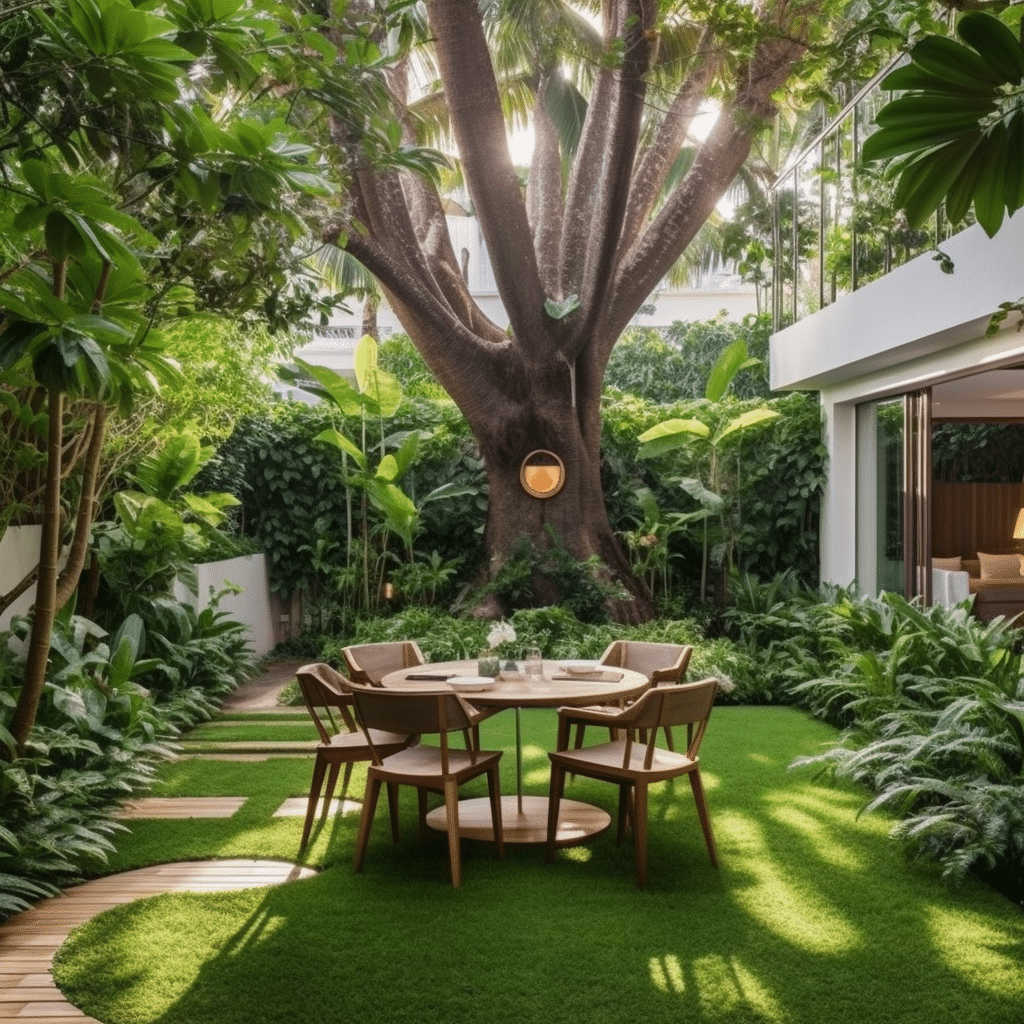.jpg)
Table of Contents
Introduction to Landscaping Ideas
Landscaping ideas are creative and innovative ways to make your outdoor spaces beautiful. Whether you have a small garden or a large backyard, landscaping can turn it into a stunning oasis. Design lush gardens, incorporate water features, and add hardscapes for endless possibilities.
Create a focal point in your yard. This could be a flower bed, sculpture, or seating area. This will draw attention to specific parts of your yard.
Incorporate different levels into your design. Use terraces or retaining walls to create distinct zones. This adds visual appeal and better utilizes the space.
Think about the functionality of your outdoor space. If you like to entertain, include an outdoor kitchen or dining area. If you want to relax, install a hammock or create a meditation garden.
Landscaping has been an important part of human civilization for centuries. Ancient civilizations had elaborate gardens with water features and greenery. These can inspire modern-day landscaping ideas. Transform your backyard into a low-maintenance paradise. Weeds might be the only things growing in your social life.
Low-Maintenance Landscaping Ideas
To create low-maintenance landscaping ideas for your outdoor space, incorporate drought-tolerant plants. Discover the benefits and techniques behind incorporating these plants for water efficiency and easy upkeep. Explore how drought-tolerant plants can enhance the visual appeal and sustainability of your landscape.
Incorporating Drought-Tolerant Plants
Agave, Lavender, Yucca, and Sedum are some popular drought-tolerant plants. They need minimal water, come in many colors, sizes, and textures, and attract beneficial insects like butterflies and bees.
In my neighborhood, one house embraced drought-tolerant plants entirely. They turned their front yard into a stunning oasis with succulents, agaves, and lavender bushes. It required minimal watering and became a conversation starter among neighbors.
Eco-friendliness and low-maintenance can be achieved by incorporating drought-tolerant plants. So, turn your postage stamp-sized yard into a paradise and make tiny lemonade stands when life gives you lemons.
Landscaping Ideas for Small Spaces
To maximize your small outdoor space, explore landscaping ideas for small spaces with a focus on vertical gardening techniques. Discover how these techniques offer innovative solutions to make the most of limited space while adding greenery and beauty to your surroundings.
Vertical Gardening Techniques for Limited Space
Vertical gardening is a great way to get the most out of limited space. Here are five techniques to help you out:
- Wall-mounted planters: Hang planters on walls and take up minimal floor space.
- Hanging baskets: Hang baskets from ceilings or hooks and add greenery.
- Trellises and arbors: Install trellises or arbors, enabling climbing plants to reach new heights.
- Stacked containers: Use tiered planters or hanging pouches to promote vertical growth.
- Pocket gardens: Use fabric pockets or shoe organizers to create cozy homes for plants.
When using vertical gardening techniques, consider the details. Pick plants that can adapt to confined spaces. Strategically use colors to create depth and expand the area. Also, use lighting solutions like LEDs for indoor gardens to ensure optimal growth.
Vertical gardening has been around for centuries. Ancient civilizations such as the Babylonians and Aztecs built terraced gardens and hanging gardens with cascading foliage. Now, you too can make the most of your limited space and turn it into a flourishing green sanctuary.
Eco-Friendly Landscaping Ideas
To create an eco-friendly landscape with native plants and rainwater harvesting as solutions, dive into the section of “Eco-Friendly Landscaping Ideas.” Here, we explore the benefits of using native plants and the practice of rainwater harvesting. Discover how these sub-sections contribute to a sustainable and environmentally conscious approach to landscaping.
Using Native Plants and Rainwater Harvesting
Going native with plants and harvesting rainwater is a savvy and eco-friendly way to get a sustainable and picturesque garden. Not only does it help save water, but it also helps the local surroundings. Consider these 6 points when you put these techniques into practice:
- Choose native plants: Those adapted to the climate require less water and attention.
- Drought-resistant varieties: Pick drought-resistant plants that can endure with little irrigation.
- Build rain gardens: Designing rain gardens lets water be caught and absorbed by the soil, reducing runoff.
- Install rain barrels: Capture rainwater using barrels or other containers, which can be used for watering during dry times.
- Use permeable materials: Place permeable pathways or driveways that let rainfall seep into the soil instead of running off.
- Irrigation systems: Think about installing drip irrigation systems that give water directly to the plant’s root zone, cutting down on evaporation and water waste.
Also, native plants and rainwater harvesting have some special benefits. Native plants draw in local wildlife like birds, butterflies, and bees, making for a more diverse ecosystem. Rainwater harvesting decreases the pressure on municipal water sources during dry seasons. In addition, these processes encourage sustainable gardening methods and can motivate others in your community.
Pro Tip: Before getting native plants, check out which ones flourish in your particular region’s climate for the best results. When it comes to making a private yard, hedges make great neighbors, but an alligator-filled moat works even better!
Landscaping Ideas for Privacy
To achieve privacy in your landscaping, consider implementing solutions like installing fencing and planting hedge rows. These sub-sections will explore the benefits and techniques for enhancing privacy through these two methods.
Installing Fencing and Planting Hedge Rows
- Determine needs: Work out your privacy needs and any other factors, like budget, local laws, or climate.
- Choose materials: Pick fencing/hedge materials that suit your style, funds, and skill level. Think of durability, height, design, and how it’ll fit with the existing landscape.
- Prepare site: Clear the spot for the fence/hedge. Mark property lines so you don’t run into legal issues down the line.
- Install fencing: Measure and put posts in at regular gaps, using proper tools. Attach panels firmly to posts, making sure they’re even and in line. Add gates and decorations if you want.
- Planting hedge rows: Ready the soil – get rid of weeds and ensure good drainage and fertilization. Dig planting holes according to the recommended spacing for your hedge type.
- Maintain and nurture: Check the fence for damage, clean it, repaint as needed, and deal with repairs quickly. Water hedges during the establishment period and trim them to get the desired shape and density.
- Consider other factors: Sunlight, wind, noise reduction – all these may influence your decision between fencing and hedge rows.
Pro Tip: When picking fencing materials or hedge varieties for privacy, get ones with sound insulation properties for extra functionality.
Transform your front yard from a bustling show to a stunning botanical paradise with landscaping ideas for curb appeal (no circus performers needed).
Landscaping Ideas for Curb Appeal
To enhance the curb appeal of your landscape, utilize pathways and flower beds. These elements not only add visual charm but also guide visitors through your front yard. Discover the transformative power of pathways and flower beds for an inviting and aesthetically pleasing outdoor space.
Enhancing the Front Yard with Pathways and Flower Beds
Transform your front yard with pathways and flower beds for an impressive curb appeal. Not only will it look visually pleasing, but also adds function and charm to the outdoor space. Pathways can lead visitors to the doorstep while adding structure and organization to the landscape. Choose pavers, gravel or natural stone for a clear direction and improved look.
Flower beds can bring color and beauty with a variety of blooms that change throughout the seasons. Mix heights and textures when designing the beds to create an interesting layering effect. Edging materials can also define boundaries and give a finished look to the landscaping design.
Focus on personal style by adding statues or decorative elements for a unique look. Plus, maintenance is key to keeping the front yard looking top-notch. Prune plants, remove weeds and keep the pathways tidy. With a little bit of green, your neighbors will be green with envy!
Budget-Friendly Landscaping Ideas
To achieve budget-friendly landscaping ideas for your outdoor spaces, turn to DIY projects and reusing materials. These sub-sections offer solutions and techniques that can help you create stunning landscapes without breaking the bank.
DIY Projects and Reusing Materials
Unleash your creativity with DIY projects and reusing materials! Transform your backyard into a unique space with a vibrant touch. Repurpose old wooden pallets to make elegant planters. Paint them in vibrant colors to add personality to your garden. Reuse glass bottles as decorative elements and hang them on tree branches or place them along pathways. Fill them with water and fresh flowers for a charming touch. Create a rock pathway using stones found in your yard. Build a trellis using recycled materials such as old ladders or wire fencing. Train climbing plants to grow on it to make a green oasis.
Incorporate unconventional items such as vintage doors or windows as garden art or boundary markers.
John Smithson once transformed an abandoned junkyard into a breathtaking garden using salvaged materials and his boundless creativity. Let this be an inspiration to you!
Be eco-friendly and creative. Roll up your sleeves, gather those discarded treasures, and let your creativity bloom in ways you never thought possible! Discover budget-friendly landscaping that will make your neighbors green with envy.
Landscaping Ideas for Entertaining
To enhance your outdoor space for entertaining, dive into landscaping ideas for entertaining with a focus on creating inviting outdoor living spaces and setting up cozy fire pits. Discover how these two sub-sections offer solutions to transform your backyard into a vibrant and cozy hub for socializing and relaxation.
Creating Outdoor Living Spaces and Setting Up Fire Pits
Transform your yard into a unique outdoor living space with landscaping elements! Use trees, shrubs, and hedges to create distinct spaces for dining, lounging, and socializing. Incorporate weather-resistant furniture, decorative lighting, an outdoor kitchen or grill area, a fire pit or fireplace, and water features for ambience.
For added visual interest, attract butterflies and hummingbirds with plants. Incorporate natural elements such as rocks or wood accents, and add shade structures like pergolas or umbrellas.
Make it even more fun with games and activities like cornhole or bocce ball. Install an outdoor movie screen or projector, and an outdoor sound system for music or dance parties. Create a welcoming atmosphere that is perfect for entertaining friends and family!
Landscaping Ideas for Children’s Play Areas
To enhance children’s play areas in your landscaping, consider incorporating play structures and synthetic turf. These additions will provide an engaging and safe environment for children to enjoy. Integrating play structures encourages physical activity and imagination, while synthetic turf offers a low-maintenance and soft surface. Let’s explore how these elements can create a vibrant and playful space for children to thrive in.
Incorporating Play Structures and Synthetic Turf
Designing a play area for children? Consider adding play structures and synthetic turf! This combination can create a safe and enjoyable environment.
- Play Structures: Slides, swings, and climbing frames can add fun and physical activity. Plus, they help kids develop coordination and balance.
- Synthetic Turf: Soft and cushioned, synthetic turf reduces the risk of injuries. Plus, it requires less maintenance than natural grass.
- Creative Elements: Interactive panels or musical installations offer hours of fun and stimulate imagination.
- Safety Considerations: Always prioritize safety. Make sure equipment meets standards and regularly inspect for hazards. Plus, choose high-quality, durable, non-toxic turf materials.
To make it even more special, add age-appropriate signage and themed decorations. And don’t forget to involve kids in the decision-making process!
With play structures and synthetic turf, you’ll have a paradise where dirt and fun coexist. What a memorable play area!
Conclusion
To end our discussion, it’s clear that landscaping ideas offer limitless possibilities for sprucing up outdoor areas. Incorporating design elements like plants, hardscapes, and water features give homeowners the ability to make a relaxing oasis.
Plus, there’s a range of landscaping styles—from traditional to modern—to suit everyone’s taste and preference. It’s essential to pay attention to detail, color coordination, and plant selection to make a unified and attractive landscape design.
On top of looks, landscaping also has practical benefits. A properly designed outdoor space can raise property value, help with environmental sustainability by cutting down runoff and improving air quality, and provide places for leisure and fun.
Research shows that the art of landscaping goes back thousands of years to ancient civilizations like the Egyptians and Persians. Through different cultural movements and design philosophies, landscaping has changed over time. Today, professional landscapers use their expertise and technology to blend nature and architecture in beautiful outdoor spaces.


